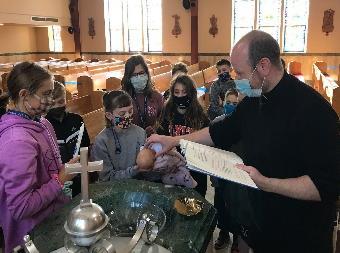
6 minute read
Tools for Touchy Topics
Engaging Young People in Conversations about Peace and Justice
“I DON’T UNDERSTAND HOW SOMEONE COULD ATTACK AND TRASH SUCH A SACRED BUILDING, ESPECIALLY IF THE REASON IS BECAUSE A PERSON YOU WANTED TO WIN DIDN’T. ”

"I am embarrassed to call myself an American. The world is looking at the wrong part of America right now.
Does any of this sound familiar? These are some quotes from students in just one of our high schools. Perhaps you have heard similar statements or have been asked similar questions. There is no doubt that the Black Lives Matter protests and violence that we witnessed last Spring and Summer to the horrible attack and events that took place at the Capitol on January 6th rocked all of our worlds, especially those of our young people. They are experiencing all sorts of emotions – sadness, fear, anger, distrust, indifference, disbelief, and they look to us teachers, ministers, and leaders for answers. It is our responsibility to help them sift through the confusion, hatred and discontent to discover and reverence the dignity of each human person. We want them to become well-informed citizens, who listen compassionately and thoughtfully, and are not afraid to respectfully disagree. It is our hope that the following materials will help you start conversations with the youth and young adults in your lives about how to be people of peace and justice.
The Art of Active Listening
In 1 Kings 17, the prophet Elijah experiences God’s presence profoundly in listening to the “sound” of silence. The dialogue between Elijah and God displays a frustrated, tired, bewildered, and a little bit belligerent creature addressing his Creator. In some ways, the dialogue between Elijah and God can serve as a starting point for us as we encourage teens and young adults to practice the art of active listening. Rather than return Elijah’s frustrated and obstinate behavior with more of the same, God listens quietly and empathizes with him. The two do not become enemies just because their viewpoints on the situation are different. In our media-hyped and polarized world, genuine listening can be hard. We all have a knee-jerk reaction to judge and blame, mute and unfriend when we read or hear something with which we don’t agree.
After the January 6 violence at the U.S. Capitol, many of us found ourselves dealing with mixed and complex emotions. Our students and children were no different, except that perhaps they lacked a place where they felt they could be heard. The world had become an even noisier place, and it was almost impossible to get in a word edgewise. In the midst of a pandemic, when screens and masks tend to mediate all of our communication, digital tools can be helpful in providing a safe place where students can share and practice listening to others. When dealing with tough topics, it may be helpful for students to be allowed to anonymously post their feelings, reactions, and opinions on the topic. But students also need to know that the goal of sharing their thoughts is simply that -- to share. And then they are invited to simply read the comments of others who are participating. Encourage students to simply notice what others are saying, to notice whether others agree or disagree with what they themselves shared. Political opinions, justifications, blame and other sorts of judgments should be kept to a minimum. Encourage students to keep it on the level of feelings and personal experience. And encourage them, as they read the other responses, to really “listen” to the other people rather than making judgments, labeling people, or putting others in a box. Remind them that differences are part of what make us unique, they enrich us and help us to grow in our acceptance of others. Remind students that disagreements on issues do not mean that people automatically have to be enemies. An exercise like this could also be done in-person, circumstances and group dynamics permitting, and students could be asked to share verbally or using sticky notes on a wall. These practices could be repeated with other complex topics to encourage students to listen to each other on a more regular basis.
The Art of De-mything Social Media
When dealing with youth in middle school, social media becomes a platform for their understanding of truth. In their minds, everything is either black or white. These young minds are quite not yet ready for the art of active listening. This age needs your help to navigate the “truths” they hear from all kinds of media. Here is an invitation for developing a sense of awareness of the “other. ” As a leader, you need to create a space for your teens to state what they have heard and then help them to see from another perspective. A great way to help these young people grow in their awareness is to practice the art of questioning like Jesus. When the Pharisees questioned Jesus about specific truths, he returned in favor with more questions! This is a wonderful practice when working with middle school youth. The process of engaging youth with questions gives them the opportunity to find the gray area in the midst of what they see as black and white. Questions become a platform for seeing there is more than what they have heard or seen. Questions allow them to become aware! They may not have all the answers, but it helps them to realize the world is bigger than their narrow world view and begins a journey towards growing in compassion and understanding.
The Art of Prayer in the Year of St. Joseph
On December 8, 2020 the Church celebrated the 150th anniversary of the proclamation of St. Joseph as the patron saint of the universal church. In his Apostolic Letter, Patris Corde (With a Father’s Heart), Pope Francis describes St. Joseph as exhibiting creative courage from agreeing to be Mary's husband to fleeing to Egypt in order to protect Jesus and Mary.
So what is creative courage?
In difficult times, we often question why God does not act more clearly or directly. Pope Francis says that this is because God works through people to accomplish his will. , such as with St. Joseph, who chose creative ways to respond to difficulty. Rather than accepting that there were no lodgings for his family, St. Joseph “took a stable and, as best he could, turned it into a welcoming home for the Son of God to come into the world. ” “In the face of difficulty, we can either give up and walk away, or somehow engage it."
The Good News of the Gospel consists in showing that for all the arrogance and violence of worldly powers, God always finds a way to carry out His saving plan.
Just as St. Joseph showed creative courage in difficulties, we are called to do the same to bring about hope in these difficult and uncertain times.
By considering St. Joseph’s creative courage in the Scriptures, we can see how God calls each and every one of us to accomplish His will. We must imitate St. Joseph by responding with creative courage. When it seems that God may not be helping, He is really trusting us to be creative and find solutions. Only then can we follow in the footsteps of St. Joseph who was "able to turn a problem into a possibility by trusting in divine providence, ” giving hope to the world.









